Podcast
Questions and Answers
What is the primary concern when using chemical paint removal?
What is the primary concern when using chemical paint removal?
- It is a slow and laborious process
- It is hazardous and requires consultation of the TO (correct)
- It is only used for advanced composites
- It is not effective for topcoat removal
What is the main difference between topcoat and primer removal?
What is the main difference between topcoat and primer removal?
- The speed of removal
- The type of abrasive used (correct)
- The type of paint used
- The method of removal
What is the preferred method of paint removal for advanced composites?
What is the preferred method of paint removal for advanced composites?
- Mechanical paint removal
- Dry abrasive blasting
- Chemical paint removal
- Plastic media blasting (correct)
What is the minimum RPM rating required for attachments when using motor-driven abrasives?
What is the minimum RPM rating required for attachments when using motor-driven abrasives?
What is the purpose of cleaning and inspecting the area during removal prep?
What is the purpose of cleaning and inspecting the area during removal prep?
What is the benefit of using plastic media blasting for paint removal?
What is the benefit of using plastic media blasting for paint removal?
What is the purpose of using a HEPA vacuum during plastic media blasting?
What is the purpose of using a HEPA vacuum during plastic media blasting?
What is the limitation of dry abrasive blasting for paint removal?
What is the limitation of dry abrasive blasting for paint removal?
What is the primary concern when using abrasive mats for paint removal?
What is the primary concern when using abrasive mats for paint removal?
What is the importance of protecting/masking off special areas during removal prep?
What is the importance of protecting/masking off special areas during removal prep?
Study Notes
Surface Defects
- Pinhole cavities: Caused by insufficient primer dry time and painting over volatile gases
- Peeling: Due to improper roughing or moisture removal
- Blistering: Caused by moisture, resembling water blisters
- Fish eyes: Caused by silicon left on the surface
- Pitting/cupping: Caused by corrosion left on the surface
- Crazing/mudcracking/checking: Caused by painting over a hard glossy coat
- Sandpaper finish: Due to insufficient scuffing, unsatisfactory primer, improper cleaning, or stroking gun too far away
Surface Defects due to Improper Use of Technique Applications
- Runs and sags: Caused by too heavy of a paint application due to spraying too close at uneven angles
- Streaks: Caused by improper overlapping and air pressure being too high
- Orange peel: Caused by insufficient thinning due to the coating being too thick
Defects due to Equipment and Need for Adjustment
- Heavy center: Caused by low atomizing pressure, fluid pressure too high (air low)
- Split spray: Caused by atomizing pressure high, air pressure high, and fluid low
- Heavy top/bottom & heavy left/right: Caused by air cap clogged (check for dirt/burr)
- Wrinkling: Caused by coats applied fast, humidity, and rising temperatures
- Blushing: Caused by moisture condensation from the atmosphere
Faulty Finishing Material
- Faulty finishing material: Caused by coating/paint being stored improperly or material being expired
Spray Gun Troubleshooting
- Paint doesn't spray: Check for paint, blockage
- Paint doesn't transfer: Check for dirty tool or clogged air vent/cup cover
- Excessive fog: Check for pressure being too high
- If paint leaks: Check fluid tip, tip may be damaged or needle and tip may be different
- If paint gun sputters: Check fluid tip, may be loose, tighten all assemblies
Passivation Coating
- Passivation coating: Treats/coats metal to reduce chemical reactivity of its surface
- Surface prep/prior coating: Cleaning surface, solvent wipe, and water break test
- Chromate conversion coating (alodine): Used on aluminum and alloys
- Application of passivation coating: Apply immediately after corrosion removal, immersion/submersion/dunking is the best method
Coating Defects
- Adhesion: Surface is roughened or cleaned to promote adherence/stick
- Coating: Consists of a primer and topcoat
- Primer: Promotes corrosion protection for metal and is an adherent for the top coat
- Top coat: Provides toughness, outdoor durability, and good chemical resistance
- Vehicle: Liquid portion of the coating, consisting of volatiles and non-volatiles
- Volatile: Solvents and dilutants lost through evaporation in curing
- Non-volatile: Pigments and resins that form and leave an actual film on the surface
- Viscosity: Liquid's resistance to flow, measured with a viscometer
Improper Surface Treatment Defects
- Block 8: Improper surface treatment defect
Coating Removal
- TO 1-1-8: Removal of applications of organic coatings, and PPE
- TO 1-1-690: General Advanced composites repairs
- Mechanical Compatibility: Using the right tool for the right job
- Material Compatibility: Using compatible materials for a job
- Removal prep: Includes cleaning and inspecting the area, allowing the area to dry, protecting/masking off any special area, and positioning aircraft in a sheltered area
- Types of paint removal: Chemical and mechanical paint removal
- Chemical paint removal: Fastest and easiest method, but hazardous, and not authorized on advanced composites
- Mechanical paint removal: Includes abrasive cloths/paper and abrasive mats, top coat removal requires a courser grit (grade C), and primer removal requires a finer grade (grade B)
Plastic Media Blasting (PMB)
- PMB: A form of paint removal, preferred method for advanced composites
- Cleanup: HEPA vacuum, or compressed air with no more than 30psi when unavailable
Studying That Suits You
Use AI to generate personalized quizzes and flashcards to suit your learning preferences.
Related Documents
Description
Learn about the process of treating metal surfaces to reduce chemical reactivity, including surface preparation, cleaning, and applying passivation coatings such as chromate conversion coating.




